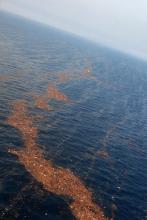After the earthquake in Japan last month, the subsequent tsunami wiped huge sections of Japan's coastline clean. As the tsunami receded, it sucked all of the debris off the land and into the sea. Where it began slowly drifting into the Pacific Ocean's circulation, heading first for Hawaii and eventually to make landfall on the continental U.S.
"Can you imagine San Francisco put through a shredder?" oceanographer Curtis Ebbsmeyer asks.
It will take about three years for the debris plume to reach the beaches of British Columbia, Washington, Oregon, and California. The University of Hawaii's International Pacific Research Center has forecast the bulk of the debris to make landfall in California, sometime in the middle of the year 2016. But the leading edge of the debris plume will spread out along the entire western coastline, beginning as early as late 2013.
The debris field will be following the North Equatorial Current, which flows from east to west across the Pacific. After the North Equatorial Current hits the western coast of the United States it spins off into the Pacific Gyre, which is the home of the infamous Garbage Patch. Unfortunately, quite a lot of debris from the Japanese earthquake will end up in the Garbage Patch at the end of its journey, contributing unknown tons of debris to that already-clogged area of the ocean.
The debris which will make landfall on the continental United States will have been in the ocean for several years by that point. Although there were some early morbid theories that human remains might wash up on our shores, this seems extremely unlikely given the distance and the time frame. Even the infamous disembodied feet in sneakers which washed up on Pacific Northwest beaches had only been floating for a few months at the most.
Most of the beachcombing remains will likely be housing debris - wood frames, shingles, window frames, studs, floorboards, etc. And the rest will likely be plastic consumer waste (toys, bottles, cushions, wrappers), which unfortunately floats indefinitely. Mixed in with a heap of uprooted trees, tires, and other random bits that survive the journey.
There was some initial concern that the debris field might be radioactive, after the Fukushima plant's meltdown. However, most of this debris was pulled off the Japanese coastline several hours before the plant experienced problems. Even if it had been radioactive, several years floating in the ocean would typically be enough to render the items harmless by the time they reach us.
"Can you imagine San Francisco put through a shredder?" oceanographer Curtis Ebbsmeyer asks.
It will take about three years for the debris plume to reach the beaches of British Columbia, Washington, Oregon, and California. The University of Hawaii's International Pacific Research Center has forecast the bulk of the debris to make landfall in California, sometime in the middle of the year 2016. But the leading edge of the debris plume will spread out along the entire western coastline, beginning as early as late 2013.
The debris field will be following the North Equatorial Current, which flows from east to west across the Pacific. After the North Equatorial Current hits the western coast of the United States it spins off into the Pacific Gyre, which is the home of the infamous Garbage Patch. Unfortunately, quite a lot of debris from the Japanese earthquake will end up in the Garbage Patch at the end of its journey, contributing unknown tons of debris to that already-clogged area of the ocean.
The debris which will make landfall on the continental United States will have been in the ocean for several years by that point. Although there were some early morbid theories that human remains might wash up on our shores, this seems extremely unlikely given the distance and the time frame. Even the infamous disembodied feet in sneakers which washed up on Pacific Northwest beaches had only been floating for a few months at the most.
Most of the beachcombing remains will likely be housing debris - wood frames, shingles, window frames, studs, floorboards, etc. And the rest will likely be plastic consumer waste (toys, bottles, cushions, wrappers), which unfortunately floats indefinitely. Mixed in with a heap of uprooted trees, tires, and other random bits that survive the journey.
There was some initial concern that the debris field might be radioactive, after the Fukushima plant's meltdown. However, most of this debris was pulled off the Japanese coastline several hours before the plant experienced problems. Even if it had been radioactive, several years floating in the ocean would typically be enough to render the items harmless by the time they reach us.
